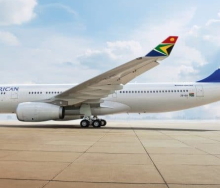WHILE African airlines
saw 2017 traffic rise
7,5% compared with the
previous year, according
to Iata statistics, regional
passenger numbers at
Acsa airports are down
1%. For the same period,
international and domestic
passenger numbers grew
5% and 4% respectively.
Commenting on Acsa’s
financial results for the
2017-18 year, acting cfo,
Dirk Kunz, said overall
passenger growth at Acsa
airports reflected good
load factors and the larger
aircraft that had been
placed on routes into
South Africa’s airports.
He explained that, while
domestic landings had
dipped 1% and international
landings had only increased
by 3%, passenger volumes
had shown more growth.
Regional landings showed
no movement, suggesting
decreased load factors on
regional routes.
The decline in regional
traffic comes at a time
when South Africa’s
economy has suffered,
along with regional
neighbours’ economies,
driven in part by the
weakened commodities
market. This has resulted
in a decline in air traffic
on regional routes serving
mining areas.
Reporting its financials
for the year ending March
2017, SAA also revealed
that it had lost considerable
market share – 23, 45
and 71 percentage points
in the domestic, regional
and international space
respectively.
SAA’s loss in regional
market share came
alongside market share
gains by Ethiopian Airlines
and Air Namibia. SAA has
not released its financials
for the year ending March.
In September last year,
SAA also announced a
reduction in frequencies
on its Brazzaville via Pointe
Noire; Douala via Libreville;
Kinshasa; Entebbe; Luanda;
and Cotonou via Libreville
routes.
SA loses shares of regional flights
07 Nov 2018 - by Tessa Reed
Comments | 0













